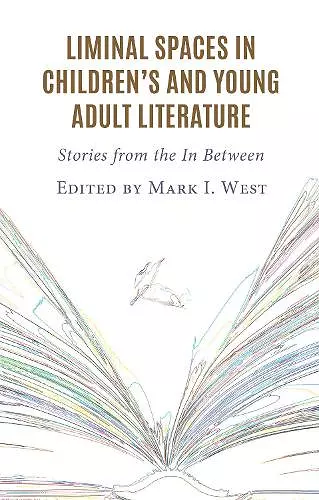Liminal Spaces in Children’s and Young Adult Literature
Stories from the In Between
Mark I West author Mark I West editor
Format:Hardback
Publisher:Bloomsbury Publishing PLC
Published:29th Mar '24
Currently unavailable, and unfortunately no date known when it will be back

Scholars in the field of children’s literature studies began taking an interest in the concept of “liminal spaces” around the turn of the 21st century. For the first time, Liminal Spaces in Children’s and Young Adult Literature: Stories from the In Between brings together in one volume a collection of original essays on this topic by leading children’s literature scholars. The contributors in this collection take a wide variety of approaches to their explorations of liminal spaces in children’s and young adult literature. Some discuss how children’s books portray the liminal nature of physical spaces, such as the children’s room in a library. Others deal with more abstract portrayals, such as the imaginary space where Max goes to escape the reality of his bedroom in Maurice Sendak’s Where the Wild Things Are. All of the contributors, however, provide keen insights into how liminal spaces figure in children’s and young adult literature.
Together, the essays in this readable and enlightening collection testify to the centrality of liminal spaces in children's literature. * Children's Literature Association Quarterly *
The essays in Liminal Spaces in Children’s and Young Adult Literature, edited by West, considers multiple interpretations of liminality in children’s and young adult literature. The collection is divided into two parts. The first part of the collection includes essays on “clusters” of books written for children or young adults exploring themes and genres that consider connections between texts in their treatment of liminal spaces. Examples include Claudia Mills’s chapter, which considers children’s books set in libraries, examining the library as a physical liminal space. Scott G. Eberle’s analysis of found objects and portal fantasies in the work of C.S. Lewis and Francis Hodgson Burnett considers imaginative, or abstract, liminal spaces. The second part of the collection includes essays about individual works in which the author’s use of liminal space is an essential component of the story. Examples include Trina Marie Rumfelt’s chapter focusing on Kathrine Paterson’s use of liminal space as escape from the pressures of reality in The Bridge to Terabithia. Sarah Minslow’s chapter considers liminality and double consciousness in Angeline Boulley’s young adult novel The Firekeeper’s Daughter, whose protagonist is Ojibwe and white. Recommended. Advanced undergraduates through faculty; professionals. * Choice Reviews *
It overwhelmingly achieves its objective of recentering the conversation in children's literature studies on the liminal as dynamic, exciting, and even quasi-magical space in which children may encounter and interact with profound ways of being and belonging. * Children's Literature *
Liminal Spaces in Children's and Young Adult Literature throws open many portals and doors into such metaphorical gardens of possibilities. * Journal of American Culture *
A lively and diverse set of meditations on liminality in and around children’s literature, as observable in both single texts (as in the essays in Part Two) and across multitextual and/or multigeneric registers (as in Part One). Addressing titles and contexts both familiar and surprising, contributors show how literature makes the most of liminality’s affordances, enlarging our options for thinking, learning, and living. -- Kenneth Kidd, University of Florida
ISBN: 9781666938876
Dimensions: 237mm x 159mm x 24mm
Weight: 544g
230 pages